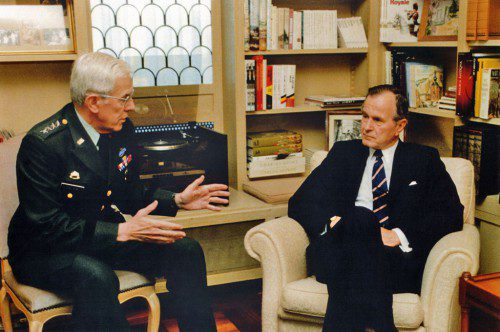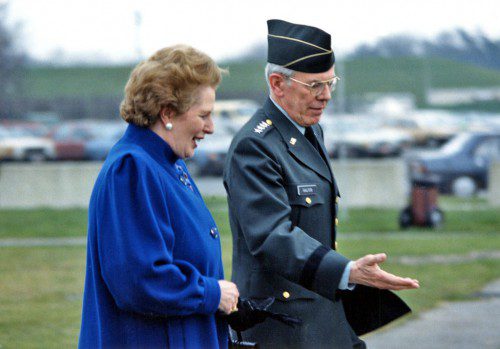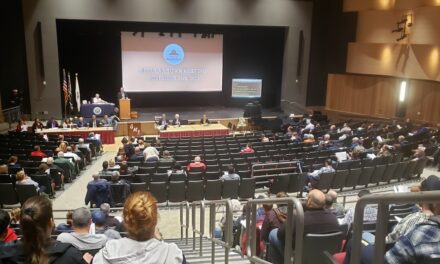
AS NATO’S TOP military leader, General John R. Galvin was often asked for input by men like President George H.W. Bush. (Photo courtesy of Mark Curley)
This is the first of two parts.
WAKEFIELD — John Rogers Galvin, mason’s son and retired four star U.S. Army General, will have the new middle school rededicated in his honor Saturday, Nov. 15. As the ceremony approaches, we reflect on the general’s early years here, his accomplished career as a soldier, statesman and scholar and on some of the important visits he made back to his hometown over the years.
——-
“Jack” Galvin, born in 1929, grew up on Pleasant Street, the son of local mason John J. Galvin and Josephine Rogers Galvin. The senior John Galvin plied his trade across the state and was considered one of the few men in New England qualified to restore early American fireplaces. A noted historian as well, the general’s father was a member of the Wakefield Historical Society and had particular expertise in our Revolutionary and Civil wars.
Jack Galvin attended the West Ward and Lincoln schools. In a Wakefield Item column from 1968, he is described as having been a hod carrier as a young man, meaning he helped lug bricks and mortar for his father. He also was a newspaper delivery boy for this newspaper serving Albion Street and parts of the West Side of town. He also worked as a pin setter for the Wakefield Bowladrome in the days before electric pin setters which reset the pins with the push of a button. He was popular with his classmates and was a talented cartoonist as well. Jack and others in his class were born the year of the great stock market crash and grew up during the Depression.
In a Veterans’ Day ceremony 20 years ago, the general recalled watching in awe as old soldiers dressed in still-fitting uniforms marched in the town’s various parades. Jack was just a boy and some of those he marveled at were Civil War veterans.
The future general graduated from Wakefield High School in 1947 and attended Merrimack College, BU and art school briefly. At 19, he enlisted as a private and joined the 182nd Infantry, Massachusetts National Guard, the Army’s oldest unit and descendant of the Minutemen. In December 1949, Massachusetts Governor Paul Dever nominated Galvin from the enlisted men of the state National Guard to take the entrance exam to the military academy at West Point. In June 1950 he received orders to report to West Point on July 5.
In his first year at West Point, Jack was a serious student who also used his wit, ability and understanding as a cartoonist for The Pointer, the academy’s official magazine. A January 1951 report in his hometown paper detailed the work.
“Two full pages of cartoons drawn by Galvin, titled ‘Shadows … By Jack Galvin’ illustrate what cadets would like to do under various circumstances. One drawing shows a cadet out of bed, sleepily looking at his alarm clock while the shadow races madly back to the comfortable resting place. Another illustrates an upperclassman scolding a new cadet who is standing at attention. The shadow shows the cadet in a fist fight with the senior cadet. With it is displayed in still another cartoon where a cadet is standing at attention in a blizzard while his shadow, carrying a suit case marked ‘Miami,’ leaves on the run.”

TOP U.S. ALLIES in Europe were always interested in what Gen. John R. Galvin had to say. Among them was Prime Minister Margaret Thatcher of Great Britain. (Photo courtesy of Mark Curley)
In 1954, Jack graduated West Point as a second lieutenant of the infantry. His career quickly took off. He completed Ranger and Airborne schooling and for a year was a rifle platoon leader in Puerto Rico. He was sent to the Colombian Andes as a Ranger adviser, returning in 1958 to the 501st Airborne Battle Group, 101st Airborne Division, at Fort Campbell, Ky. There he was in command of the “D” and later “A” companies. In 1960, Galvin attended the Armor Officer Advanced Course at Fort Knox. Upon graduation he married Virginia Lee Brennan.
After a year of graduate studies at Columbia University, he received a master’s degree in History and an assignment to West Point as an English instructor. Following this tour he attended the Command and General Staff College at Fort Leavenworth, Kan. As part of the Master of Military Science Program, Galvin wrote the important book “The Minute Men,” a study of the opening battles of the American Revolution.
From 1966 to 1970, he served two years in Vietnam, mostly in the First Cavalry Division, where he commanded the First Battalion, Eighth Cavalry during the Cambodia incursion, receiving the Silver Star and Distinguished Flying Cross. In the interim he was a military assistant to Secretary of the Army Stanley Resor. He also wrote “Air Assault,” on the development of air mobility.
After a staff assignment in Combat Developments Command, he attended the Fletcher School of Law and Diplomacy at Tufts University in the Army War College Research Fellowship Program. During this year, he wrote “Three Men of Boston,” a political study of the events leading up to the first battle of the American Revolution.
Assigned to Europe, he served as military assistant to Generals Andrew Goodpaster and Alexander Haig at Supreme Headquarters, Allied Powers Europe in Belgium, then as Commander, Division Support Command and later Chief of Staff, Third Infantry Division (Mechanized) in Wirzburg, Germany.
He was promoted to Brigadier General in 1978 and became Assistant Division Commander, Eighth Infantry Division (Mechanized), Mainz.
In the summer of 1980, after seven years in Europe during the on-going Cold War, he was reassigned to the Training and Doctrine Command, Fort Monroe, Va. as Assistant Deputy Chief of Staff for Training. He was promoted to Major General in May 1981 and assumed command of the 24th Infantry Division (Mechanized), Fort Stewart, Ga. on June 1, 1981.
In the mid-1980s, General Galvin was commander of all U.S. forces in Central America, continuing his rise through the upper ranks of the military. In February 1987, after some months of conjecture, he was named Supreme Allied Commander in Europe as the Cold War began to thaw. Before his appointment to command NATO, the general told the Daily Item, “At this point it’s (NATO’s move), just a rumor. There are a lot of changes coming in the high command next spring. I’m a soldier and I will go where they tell me to go.”
Next: A native son becomes military leader of NATO.




